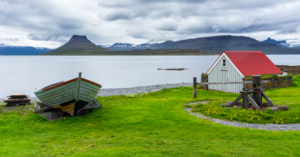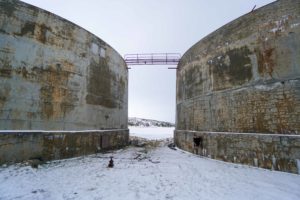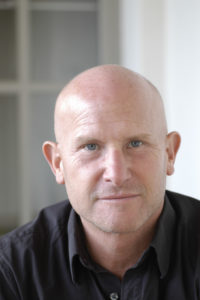This blog was written for the RSA Blog Student Summer Series that will highlight graduate student success in regional studies across the globe throughout the summer.
Iceland’s remote communities are experiencing the combined impact of declining fisheries, de-population and socio-economic instability. Having spent twenty years working on industrial heritage conservation in a professional capacity I jumped at the opportunity to see if empirical findings from ‘real world’ projects could be mirrored in qualitative research. So, thanks to a new Master’s programme on regional development in the Westfjords of Iceland, I set out to establish whether the repurposing of industrial heritage can drive regeneration in remote coastal communities.

© Silaghi Octavian – Shutterstock
Disused Fishery Sites and Regeneration
At 16 disused industrial sites connected with fisheries I conducted 50 stakeholder interviews between 2019-2021 – participants agreed to be identified and comments were attributable. Nearly 3000 segments were categorised into 42 subcodes using data app MAXQDA.
Interviewees linked fish factories with past hardship, economic failure and exploitation – thus the conservation and repurposing of such sites generated largely negative reactions, possibly linked to a masculine historical narrative as onshore fish processing was largely carried out by women. Industrial heritage was also seen as unsightly, lacking the elegance of the bourgeois built environment (castles, churches, residences) – although such perceptions tend to reverse once conservation is complete and projects publicly accessible. Volunteering in conservation was also associated with exploitation, a surprising finding given the success of conservation volunteering in Europe – and despite active volunteering in other sectors in Iceland.
Regional planning generated considerable criticism, with national policy apparently drawn up without inter-departmental consultation and local municipalities making demolition decisions contrary to the Culture Agency’s expert recommendations – thus the agency is seen as ‘light touch’ and easily ignored.
Among examples of buildings at risk, a power plant designed by renowned architect Thordarson in the remote town of Vopnafjörður is threatened with demolition despite an official report underlining its significance.
Little harmonisation seems to exist between tourism policy and the built environment – particularly industrial heritage and a cultural tendency to prioritise commercial priorities over heritage protection seems to prevail, with little assessment of environmental issues such as loss of embodied carbon from demolition and no incentive to consider waste minimisation. Current legislation protects all buildings over 100 years old, committing the state to subsidies across a growing stock of buildings – not all of which are of significant value.
Successful conservation projects were commonly those that provide art, innovation or learning hubs within their communities, creating virtuous cycles of engagement and support. Partnerships were also seen as critical to success, yet some existing tourist trails – such as the established European Route of Industrial Heritage – are almost unknown in Iceland. Another commonality related to the driven individuals who drive conservation campaigns: mostly from creative industries, skilled in visualising unrealised ideas, usually good communicators and effective in galvanising support against demolition.
Interviewees mentioned personal struggles to maintain motivation given the conservation challenges – including costs, public opposition erratic funding and physical scale. Yet the scale of these sites – especially in isolated natural locations – is also integral to their striking visual appeal.

© David Kampfner
Key Conclusions and Policy Recommendations
The research led to five key conclusions:
- . Statutory legislation relies on arbitrary age listing, leaving many significant newer buildings unprotected.
- A lack of public interest in industrial heritage appears widespread – associated with memories of shame and hardship.
- A lack of coherent planning fails to acknowledge the link between industrial heritage and tourism.
- Regional funding for the conservation of industrial heritage appears largely piecemeal and erratic.
- The potential benefits of social cohesion and skills transfer through managed volunteer projects are being missed
Interviewees also spoke of the need to move away from unsustainable, high volume, low-cost tourism and the research shows that creative re-use projects can be effective in attracting slower, more engaged domestic audiences seeking innovative cultural draws. However key caveats to success need to be addressed – hence the following policy recommendations:
- Creation of a national industrial heritage trail integrated into European Route of Industrial Heritage
- Recognition of the historic built environment in regional development and tourism policy.
- New legislation to protect significant 20th century buildings, providing the Culture Agency with suitable enforcement powers
- Development of 20th century listed buildings register
- Creation of a national volunteering agency to encourage skills transfer and build social cohesion.
Many significant industrial buildings have already been demolished or lost, yet many others have been successfully transformed, building empowered communities and acting as significant investment multipliers. More marginal sites are at a fragile juncture, needing urgent support to catalyse similar regenerative effects, while for others it may be too late.

David Kampfner (Twitter @DavidKampfner ; Website) is a Master’s student in Coastal Communities and Regional Development at the University Centre of the West Fjords in Iceland, is a researcher and consultant with SMEs and NGOs in asset conservation and resource management, specializing in the built environment and heritage protection.
Are you currently involved with regional research, policy, and development? The Regional Studies Association is accepting articles for their online blog. For more information, contact the Blog Editor at rsablog@regionalstudies.org.